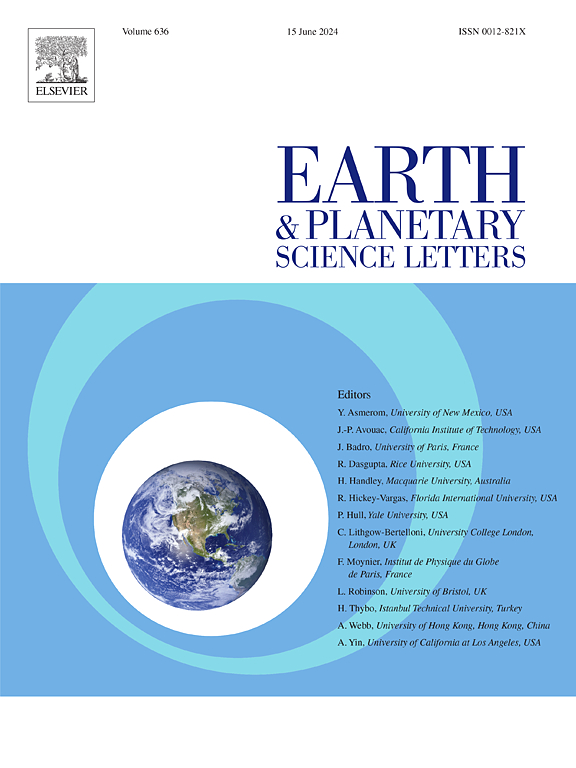Experimental investigation of hydrogen isotope fractionation during hydration of olivine-hosted melt inclusions: Implications for D/H in Baffin Island picrites
IF 4.8
1区 地球科学
Q1 GEOCHEMISTRY & GEOPHYSICS
引用次数: 0
Abstract
Olivine-hosted melt inclusions are used to investigate the hydrogen isotope compositions (D/H) of Earth's mantle reservoirs. Studies have shown, however, that hydrogen in melt inclusion can equilibrate rapidly in response to changes to the external environment via the diffusion of protons (H+) and deuterons (D+) through the host olivine. Given that protons diffuse faster than deuterons, a kinetic fractionation of hydrogen isotopes is expected to accompany both the hydration and dehydration of melt inclusions. Other volatile species in the melt inclusion may also be affected by changes to the internal pressure and/or oxygen fugacity (fO2). Here we report results from experiments designed to investigate the behaviors of volatiles and hydrogen isotopes during the hydration of olivine-hosted melt inclusions. We show that the concentration of H2O in initially H2O-poor inclusions increases rapidly (up to ∼4 wt.% within 24 h) when the host olivine is in contact with aqueous fluid at 1200 °C and 300 MPa. The extent of hydration is controlled by time, temperature, melt inclusion volume, and H+ diffusion distance. Hydrogen isotopes initially become lighter (i.e., D/H decreases) as hydration proceeds, defining a negative correlation with H2O concentration. This trend reverses with increasing hydration as the inclusions must eventually equilibrate with the external fluid. These experimental results agree well with diffusion calculations carried out using a spherical geometry and a lattice diffusivity of 10–11.2±0.2 m2/s for H+ at 1200 °C. Therefore, anomalously light hydrogen isotopes in olivine-hosted melt inclusions from Baffin Island may not be taken as representative of the composition of the mantle source unless post-entrapment hydration can be excluded as a possibility. An increase in CO2 concentration and a significant drop in sulfur concentration accompany hydration of the melt inclusions in our experiments. The former is consistent with an observed decrease in vapor bubble size and results from a hydration-induced internal pressure increase. The latter is ascribed to the exsolution of molten sulfide from the silicate melt, which might be related to a lower fO2 in the experiments as compared to the starting materials. We find no evidence for exchange of F or Cl between the melt inclusion and external fluid.
橄榄石托管熔融包裹体水化过程中氢同位素分馏的实验研究:对巴芬岛皮卡岩中 D/H 的影响
橄榄石寄生熔融包裹体被用来研究地球地幔储层的氢同位素组成(D/H)。然而,研究表明,通过质子(H+)和氘核(D+)在橄榄石中的扩散,熔融包裹体中的氢可以随着外部环境的变化而迅速平衡。由于质子的扩散速度比氘核快,因此在熔融包裹体水合和脱水的过程中,氢同位素会发生动力学分馏。熔融包裹体中的其他挥发性物质也可能受到内部压力和/或氧气富集度(fO2)变化的影响。在此,我们报告了旨在研究橄榄石包裹体水化过程中挥发物和氢同位素行为的实验结果。我们的研究表明,当主橄榄石在 1200 °C 和 300 MPa 条件下与水性流体接触时,最初贫含 H2O 的包裹体中的 H2O 浓度会迅速增加(在 24 小时内达到 ∼ 4 wt.%)。水合的程度受时间、温度、熔融包裹体体积和 H+ 扩散距离的控制。随着水化的进行,氢同位素最初会变轻(即 D/H 降低),与 H2O 浓度呈负相关。由于夹杂物最终必须与外部流体达到平衡,这种趋势会随着水化程度的增加而逆转。这些实验结果与使用球形几何图形和 1200 °C 时 H+ 的晶格扩散率(10-11.2±0.2 m2/s)进行的扩散计算结果非常吻合。因此,巴芬岛橄榄岩包裹体中异常轻的氢同位素不能作为地幔源成分的代表,除非可以排除萃取后水合作用的可能性。在我们的实验中,伴随着熔融包裹体水合作用的是二氧化碳浓度的增加和硫浓度的显著下降。前者与观察到的蒸汽泡尺寸减小相一致,是水合引起的内部压力增加的结果。后者是由于熔融硫化物从硅酸盐熔体中溶解出来,这可能与实验中的 fO2 低于起始材料有关。我们没有发现熔融包裹体与外部流体之间进行 F 或 Cl 交换的证据。
本文章由计算机程序翻译,如有差异,请以英文原文为准。
求助全文
约1分钟内获得全文
求助全文
来源期刊

Earth and Planetary Science Letters
地学-地球化学与地球物理
CiteScore
10.30
自引率
5.70%
发文量
475
审稿时长
2.8 months
期刊介绍:
Earth and Planetary Science Letters (EPSL) is a leading journal for researchers across the entire Earth and planetary sciences community. It publishes concise, exciting, high-impact articles ("Letters") of broad interest. Its focus is on physical and chemical processes, the evolution and general properties of the Earth and planets - from their deep interiors to their atmospheres. EPSL also includes a Frontiers section, featuring invited high-profile synthesis articles by leading experts on timely topics to bring cutting-edge research to the wider community.
 求助内容:
求助内容: 应助结果提醒方式:
应助结果提醒方式:


